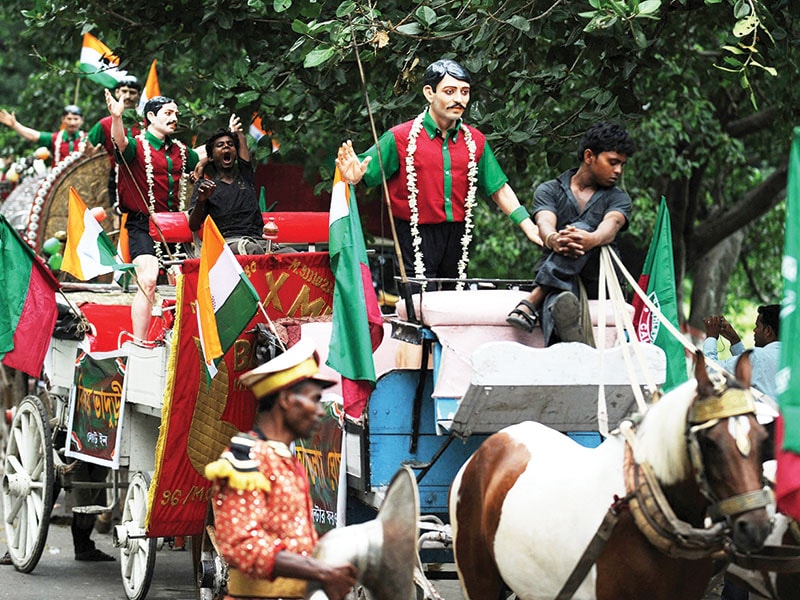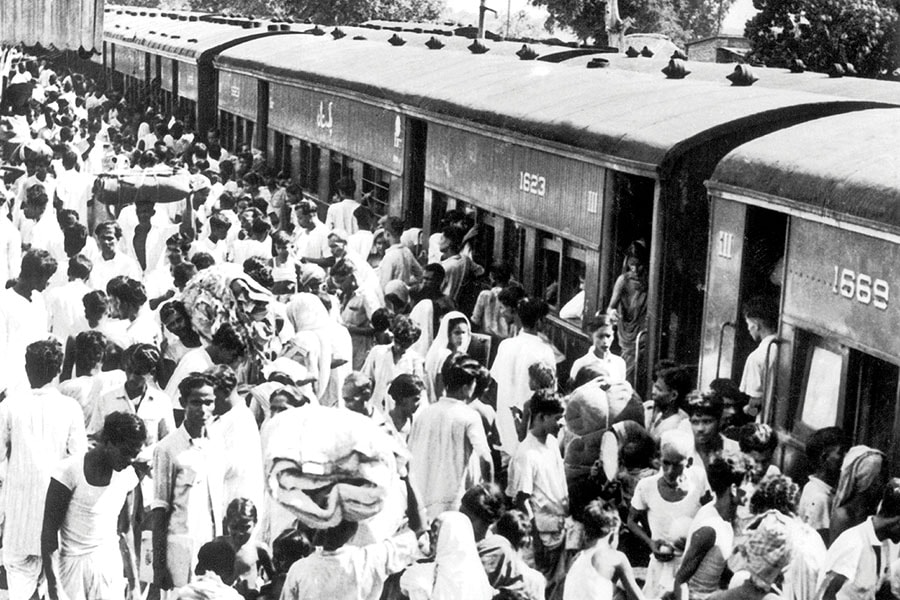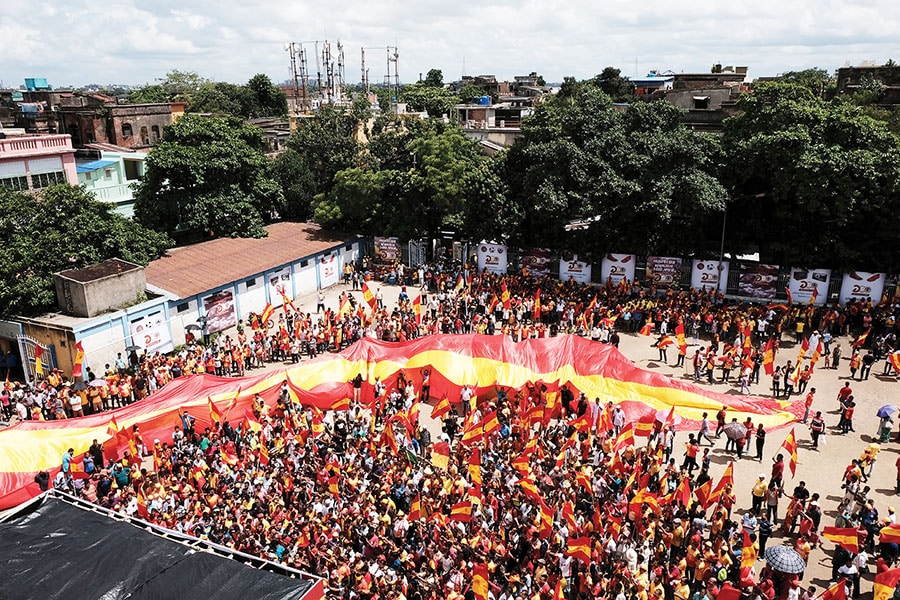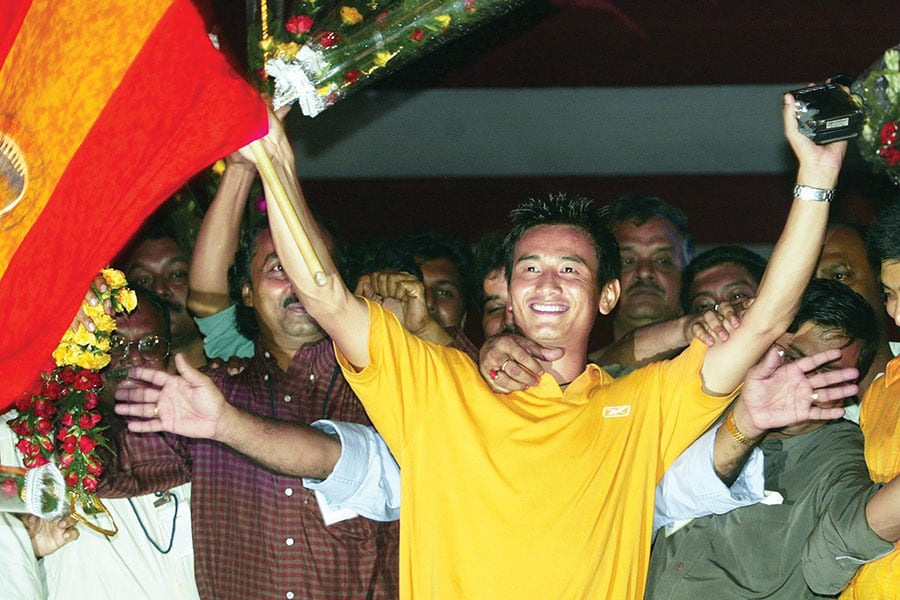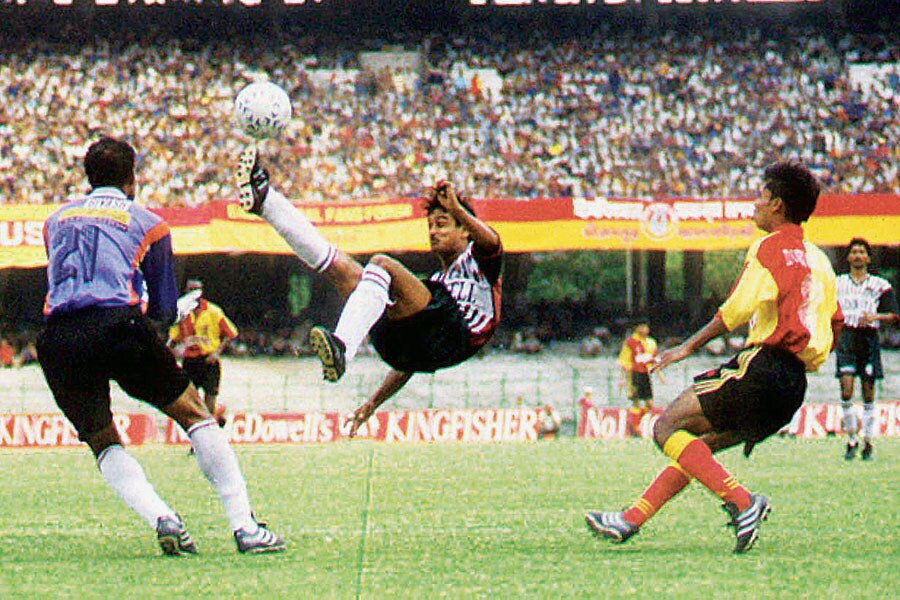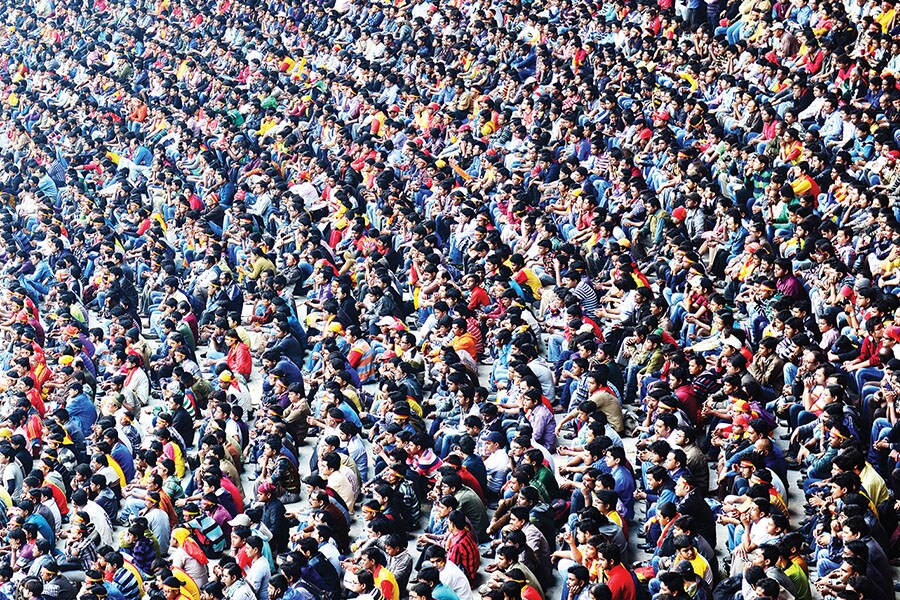There were countless allegations of police atrocities and fake encounters to eliminate Left activists. As the city of Calcutta (now Kolkata) plunged into near anarchy, the unnatural death of youngsters became a regular feature—it almost stopped making news in the local media.
Yet, the passing away of Umakanto Palodhi, a teenager, who died by suicide in the night of September 30, 1975, made headlines. He was a simple 19-year-old, an ardent fan of the Mohun Bagan Athletic Club. On the evening of September 30, his favourite club with the famous green and maroon jersey, succumbed to their worst defeat ever against arch-rivals East Bengal.
Palodhi found the 0-5 loss in the IFA Shield final too much to bear. The same night he died by suicide and left a note that said he will avenge this humiliating defeat after his rebirth. Palodhi is still remembered by the football fans in Bengal—his “sacrifice" for the club he loved and adored is now a part of football folklore in the soccer-crazy state.
Well, the case of Palodhi is certainly an unnatural one it was perhaps an instance of mental illness in medical terms. Great emotional pain and loss of hope may have led him to take the extreme step.
![]() A procession with statues of the Mohun Bagan team that won the IFA Shield at a celebration rally in Kolkata on July 29, 2011. The day is celebrated every year as ‘Mohun Bagan Day’Image: Dibyangshu Sarkar / AFP
A procession with statues of the Mohun Bagan team that won the IFA Shield at a celebration rally in Kolkata on July 29, 2011. The day is celebrated every year as ‘Mohun Bagan Day’Image: Dibyangshu Sarkar / AFP
Yet, in the state of West Bengal, still there are millions of people—between the age of 18 to 80—who consider the result of the match between Mohun Bagan and East Bengal in any domestic tournament a matter of utmost seriousness a favourable outcome can make them erupt with joy and wild celebrations, but a defeat for the preferred outfit may leave them devastated to an extent which might take weeks to recover.
This is no recent phenomenon—the rivalry that began in 1920 at a very low scale and stayed nearly unnoticed in the initial years has now grown into one of the biggest club football rivalries in Asia, if not in the world. India are placed lowly 104 on the FIFA ranking chart, but in terms of popularity and intense rivalry, a Mohun Bagan-East Bengal match ranks no lower than an El Clasico (Barcelona versus Real Madrid), the Old Firm Derby (Celtic versus Rangers) or the El Superclasico (River Plate versus Boca Juniors) in terms of popularity and social involvement.
Histories of all derby matches across the world has striking similarities They are mostly born out of racial, religious or political conflicts. El Clasico has its roots in the Spanish civil war, the Celtic versus Rangers match is seen as a rivalry between the Protestants and the Catholics. In Argentina, the contrast between the two neighbourhoods in Buenos Aires developed into an aggressive competition between River Plate and Boca Juniors.
No different is the history which made Mohun Bagan and East Bengal. The people who live across River Padma, which in the early part of the 20th century was the eastern section of undivided Bengal (now Bangladesh), are called “Bangaal". In the pre-Independence era, Bengal was considered the most progressive and advanced state in the country and it was dominated by people of Calcutta and surrounding districts (now West Bengal). They were called “Ghotis" and for generations, they had a deep dislike for people from East Bengal. In Calcutta, the “Bangaals" were always looked down upon those days their culture and language were mostly the subject of ridicule and were often discriminated in every walk of life.
It spilled over to the sporting arena too. Till 1920, Mohun Bagan, whose barefooted footballers won the 1911 IFA Shield defeating English side East Yorkshire Regiment and entered Indian football’s Hall of Fame forever, were the undisputed kings among native clubs in Calcutta football. But one incident involving a match between Mohun Bagan and Jorabagan Club changed it all.
![]() A good performance from the East Bengal club made millions of refugees from East Pakistan (now Bangladesh), who had moved over to India, temporarily forget the pain of the PartitionImage: Keystone via Getty Images
A good performance from the East Bengal club made millions of refugees from East Pakistan (now Bangladesh), who had moved over to India, temporarily forget the pain of the PartitionImage: Keystone via Getty Images
Football historian Gautam Roy, in his book East Bengal 100, said, Jorabagan Club had two “East Bengali" players in Sailesh Bose and Ramesh Chandra Sen, who were often dropped from the playing eleven. It was deeply suspected that sporting merit was not exactly the reason behind the exclusions.
Roy writes: “On Wednesday, July 28, 1920, Jorabagan Club was due to clash with Mohun Bagan in the semi-finals of the Cooch Behar Cup in Calcutta. For some unknown reason, Jorabagan Club selectors dropped Sailesh Bose and Ramesh Chandra Sen from the team."
One senior official in the Jorabagan management, Suresh Chandra Chaudhury, was from East Bengal. He refused to take this “insult" lying down and the following Sunday, he along with the two “wronged" players, Bose and Sen, sat down to finalise plans to form a new club. So, on August 1, 1920, East Bengal Club was formed in North Calcutta.
![]() East Bengal FC fans take out a massive rally to celebrate the Club’s 100th year on July 28, 2019Image: Jit Chattopadhyay / Pacific Presss / ALAMY
East Bengal FC fans take out a massive rally to celebrate the Club’s 100th year on July 28, 2019Image: Jit Chattopadhyay / Pacific Presss / ALAMY
The club’s name said it all—it didn’t make any attempt to hide its affiliation and leaning towards people from a particular part of the state. Club officials hit the nail on the head—soon the club was accepted as the natural rivals of Mohun Bagan, who were predominantly backed by people of West Bengal. Established in 1889, Mohun Bagan were older by 31 years, but East Bengal caught up with them in both fame and prestige.
The match between the two teams soon earned the tag of the biggest derby of the season tickets for the match got sold within hours with thousands still waiting outside the ticket counters the supporters of the two teams often clashed in and outside the stadium and the administration and security forces were on alert at least three days prior to the encounter.
But then, the rivalry between the two teams didn’t blossom into country’s biggest clash of club football overnight. It happened in a phased manner and like in all other cases, football was not the sole reason behind the increasing rivalry.
Till the time of Independence, the Mohun Bagan versus East Bengal match was a huge attraction of Calcutta football, but certainly not the only one. While the traditionalists preferred to follow a match between Mohun Bagan and any of the British clubs as it aroused nationalistic feelings, Mohammedan Sporting in the 1930s overshadowed both Mohun Bagan and East Bengal after their tremendous run of success in Indian football.
The partition of Bengal in 1947 brought about a huge change in the scenario. As millions of displaced persons from East Pakistan (now Bangladesh) moved over to India and were labelled as refugees, the state of West Bengal soon plunged into an economic, cultural and social crisis that was unheard of in history. The biggest hit were the refugees. The wound and scars of leaving their home and property behind and reduced to penury still fresh, their life was a constant struggle. To them, East Bengal Club were like an oasis in the desert—a good performance from their favourite club, especially against Mohun Bagan, made them forget the constant pain and battle of existence, albeit temporarily.
![]() Bhaichung Bhutia after East Bengal won the ASEAN Cup in July 2003. Bhutia holds the distinction of scoring a rare hat-trick in a Mohun Bagan-East Bengal tie
Bhaichung Bhutia after East Bengal won the ASEAN Cup in July 2003. Bhutia holds the distinction of scoring a rare hat-trick in a Mohun Bagan-East Bengal tie
The situation, on the other hand, made Mohun Bagan fans’ stand against their rivals harder. They thought the huge influx of refugees has ruined their ecosystem and the entire economy—the people from East Bengal are the source of all the trouble. Throughout the 1950s, the fans of the two clubs clashed quite often, football at the Calcutta Maidan became the source of problems with East Bengal supporters definitely playing the aggressive role on an almost daily basis.
But not everything that is there in the Mohun Bagan-East Bengal rivalry is negative. In fact, if in the first 25 years after Independence, Indian football had a strong presence at the Asian level, it was chiefly because of the two teams from Calcutta. Their presence was a big reason why football remained popular across the country—Mohun Bagan in their green and maroon jersey and East Bengal in their famous red and golden colours attracted big crowd wherever they played.
The majority of the top players to the national team came from these two clubs. The legends of Indian football, from Sailen Manna, Ahmed Khan, Jarnail Singh, Chuni Goswami, Arun Ghosh to modern day Bhaichung Bhutia, are all products of these two clubs. The majority of the titles in every national level domestic tournament have gone to the Kolkata maidan tents of either Mohun Bagan or East Bengal. Over the years, the two clubs almost became the synonym of Indian football.
![]() A match between Mohun Bagan and East Bengal in which Mohun Bagan’s defender Hussain Mustafi (centre) desperately clears the ball from their penalty area in a National Football League match in Calcutta in April 2001Image: Sportasia/ AFP
A match between Mohun Bagan and East Bengal in which Mohun Bagan’s defender Hussain Mustafi (centre) desperately clears the ball from their penalty area in a National Football League match in Calcutta in April 2001Image: Sportasia/ AFP
But nothing could match when the two clubs met. The tension and rivalry was too much to bear for the fans, in whichever part of the country the match was played. Recalls former India defender Manoranjan Bhattacharya, considered an East Bengal legend, who played many of those “boro" (big) matches over the years from 1977.
“This was one match in which I always wanted to give my best. Because I knew the millions of club fans were expecting me to deliver the goods. I remember in the 1978-79 Durand Cup, I had a fractured left hand. Yet, in the final against Mohun Bagan, I played with a plaster on the hand. We won 3-0. I simply hated to lose against Mohun Bagan, because I knew the supporters wanted us to win this match by hook or crook," says Bhattacharya.
Also watch: FIFA World Cup 2022: From Ronaldo and Messi to Courtois and Heung-min, here are the players you must watch out for
Former India captain and highly skillful striker IM Vijayan got a taste of Mohun Bagan-East Bengal rivalry while playing for the former for five seasons. “The tension was too much. With the discussions on the match starting at least one week ago and one lakh spectators in the stands, it could really tell on a player’s nerves. I was still a bit careless and refused to take the pressure, but for the local players in the team the situation used to be really difficult. Playing in a Mohun Bagan versus East Bengal match is a different experience altogether."
Exactly a similar sentiment was echoed by Bhaskar Ganguly, former India captain and goalkeeper, who played for both Mohun Bagan and East Bengal for over a decade. “In our time, a top Calcutta footballer’s social status largely depended on how he fared in the big match. Often the players on the losing side had to be sent home with police escorts. But those days are gone. What we see of Mohun Bagan, East Bengal today is just a skeleton of their former self."
![]() The tension and rivalry is too much to bear for the fans Image: Dreamstiem / IP
The tension and rivalry is too much to bear for the fans Image: Dreamstiem / IP
He is not far from the truth. A record 1,31,000 spectators watched the match at the Salt Lake Stadium on Kolkata when Bhaichung Bhutia’s superb hat-trick helped East Bengal sink Mohun Bagan 4-1 in the Federation Cup final. True, the crowd still throng the stadium in huge numbers when these two teams play, but the change in basic characters of Mohun Bagan and East Bengal has largely diluted the traditional rivalry between the two teams.
Mohun Bagan no more are the club who represents the upper-class Bengali “bhadralok" from West Bengal and East Bengal do not strictly represent or identify themselves with those, who continue to believe in fighting back against all odds. Both the clubs are now either entirely owned or run by businessmen, who basically belong to some other states. One of them have even changed the name of the club. To them, perhaps the legacy and tradition of the century old institutions do not mean much. Their idea of running a football club is completely different and definitely for good reason.
Forty-seven years ago, Umakanto Palodhi decided to end his life but vowed to be born again to extract revenge. A rebirth now may leave him thoroughly confused as it may take him some time to identify his new-look favourite club. Who knows, he might like to revisit the decision he had taken on the fateful night of September 30, 1975.

